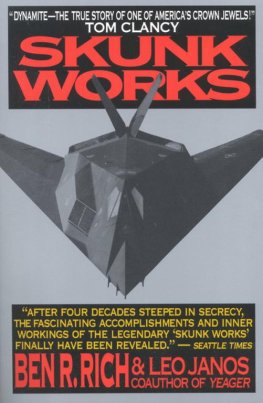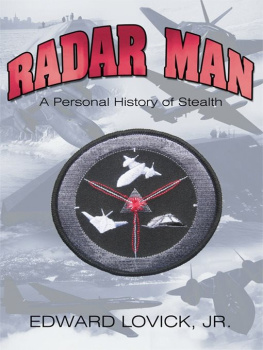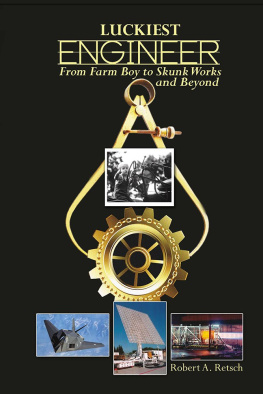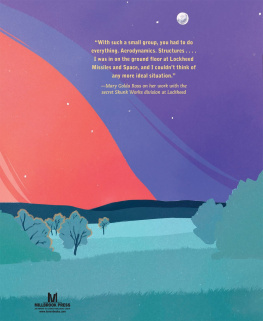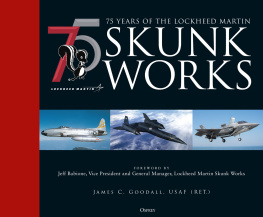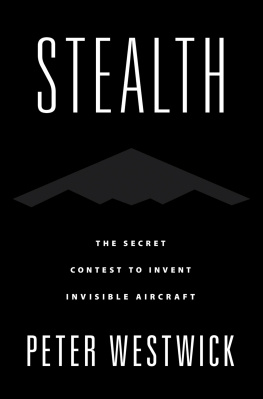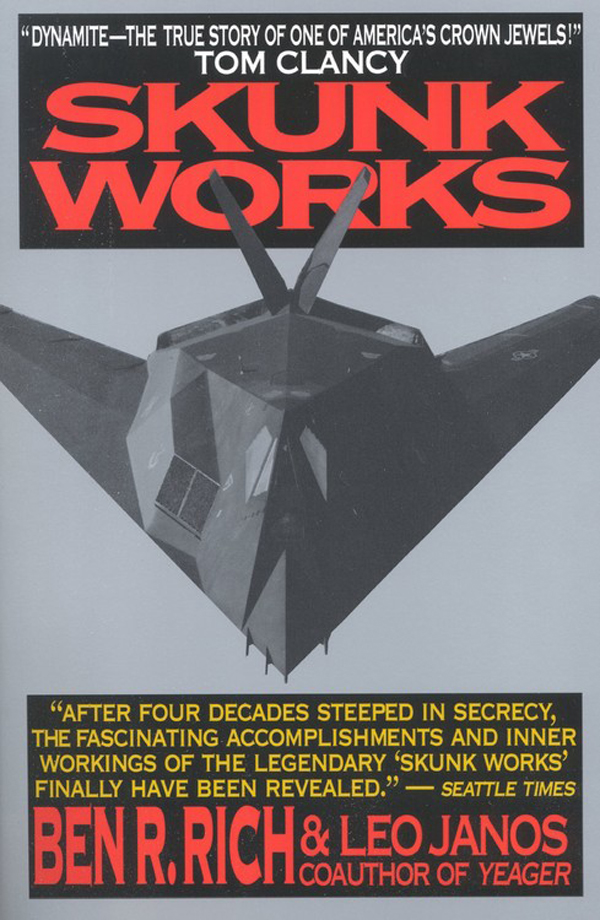In accordance with the U.S. Copyright Act of 1976, the scanning, uploading, and electronic sharing of any part of this book without the permission of the publisher constitute unlawful piracy and theft of the authors intellectual property. If you would like to use material from the book (other than for review purposes), prior written permission must be obtained by contacting the publisher at permissions@hbgusa.com. Thank you for your support of the authors rights.
Thank you for buying this e-book, published by Hachette Digital.
To receive special offers, bonus content, and news about our latest e-books and apps, sign up for our newsletter.
Sign Up
Or visit us at hachettebookgroup.com/newsletters
Copyright 1994 by Ben R. Rich
Cover design by Tom Tafuri; photograph of F-117A courtesy of U.S. Air Force
Cover copyright 2012 by Hachette Book Group, Inc.
All rights reserved. In accordance with the U.S. Copyright Act of 1976, the scanning, uploading, and electronic sharing of any part of this book without the permission of the publisher constitute unlawful piracy and theft of the authors intellectual property. If you would like to use material from the book (other than for review purposes), prior written permission must be obtained by contacting the publisher at permissions@hbgusa.com. Thank you for your support of the authors rights.
Little, Brown and Company
Hachette Book Group
237 Park Avenue, New York, NY 10017
www.littlebrown.com
www.twitter.com/littlebrown
First e-book edition: December 2012
The publisher is not responsible for websites (or their content) that are not owned by the publisher.
The Hachette Speakers Bureau provides a wide range of authors for speaking events. To find out more, go to hachettespeakersbureau.com or call (866) 376-6591.
ISBN 978-0-316-24693-4
Y EAGER
C RIME OF P ASSION
To the men and women of the Skunk Works, past, present, and future
T HE AUTHORS wish to acknowledge the contributions of various friends, co-workers, and former colleagues who enriched the pages of this book with their perspectives and recollections. Special thanks to Nancy Johnson and to Lockheeds CEO, Dan Tellep, for providing access to Kelly Johnsons logbooks and to former colleagues Sherm Mullin, Jack Gordon, Ray Passon, Dennis Thompson, Willis Hawkins, and Steve Shobert, who provided their expertise and advice through the manuscript process. Thanks also to Col. (ret.) Barry Hennessey, Pete Eames, Air Force historian Richard Hallion, and Don Welzenbach of the CIA.
Numerous Skunk Workers contributed their insights and memories. Among them: Dick Abrams, Ed Baldwin, Alan Brown, Buddy Brown, Norb Budzinske, Fred Carmody, Henry Combs, Jim Fagg, Bob Fisher, Tom Hunt, Bob Klinger, Alan Land, Tony LeVier, Red McDaris, Bob Murphy, Norm Nelson, Denys Overholser, Bill Park, Tom Pugh, Jim Ragsdale, Butch Sheffield, Steven Schoenbaum, and Dave Young.
We are particularly grateful for the participation of Air Force and CIA pilots, past and present: Bob Belor, Tony Bevacqua, William Burk Jr., Jim Cherbonneaux, Buz Carpenter, Ron Dyckman, Barry Horne, Joe Kinego, Marty Knutson, Joe Matthews, Miles Pound, Randy Elhorse, Jim Wadkins, Al Whitley, and Ed Yeilding. Significant too were the contributions of the current secretary of defense, William J. Perry, and former secretaries, Donald H. Rumsfeld, James R. Schlesinger, Harold Brown, and Caspar Weinberger; also former Chairman of the Joint Chiefs of Staff General David Jones, former Air Force Secretary Don Rice, the CIAs Richard Helms, Richard Bissell, John McMahon, Albert Bud Wheelon, and John Parangosky; Generals Leo Geary, Larry Welch, Jack Ledford, and Doug Nelson; National Security advisers Walt Rostow and Zbigniew Brzezinski, and Albert Wohlstetter, formerly of the Presidents Foreign Intelligence Advisory Board.
For obtaining photos and reference sources, appreciation to Lockheeds Denny Lombard and Eric Schulzinger, Bill Lachman and Bill Working of the Central Imaging Office, Jay Miller of Aerofax, and Tony Landis. For reference material, a salute to aviation writers Chris Pocock and Paul Crickmore.
For help often above and beyond the call of duty, our gratitude to Diana Law, Myra Gruenberg, Debbie Elliot, Karen Rich, Bert Reich, Ben Cate, and in particular to my son, Michael Rich, for his insights and suggestions, and to our wives, Hilda Rich and Bonnie Janos, for their patience and support.
Finally, our affectionate appreciation to our agent, Kathy Robbins, and to our editor, Fredrica Friedman, executive editor of Little, Brown.
Los Angeles, January 1994
Its August 1979 on the scorching Nevada desert, where Marines armed with ground-to-air Hawk missiles are trying to score a kill against my new airplane, an experimental prototype code-named Have Blue. We in the Skunk Works have built the worlds first pure stealth fighter, which is designed to evade the Hawks powerful radar tracking. The Marines hope to find Have Blue from at least fifty miles away and push all the right buttons so that the deadly Hawks will lock on. To help them, Ive actually provided Have Blues flight plan to the missile crew, which is like pointing my finger at a spot in the empty sky and saying, Aim right here. All theyve got to do is acquire the airplane on radar, and the homing system inside the Hawk missile will do the rest. Under combat conditions, that airplane would be blasted to pieces. If that defensive system locks on during this test, our experimental airplane flunks the course.
But Im confident that our stealth technology will prove too elusive for even this Hawk missiles powerful tracking system (capable of detecting a live hawk riding on the thermals from thirty miles away). What makes this stealth airplane so revolutionary is that it will deflect radar beams like a bulletproof shield, and the missile battery will never electronically see it coming. On the Hawks tracking system, our fighters radar profile would show up as smaller than a hummingbirds. At least, thats what Im betting. If Im wrong, Im in a hell of a bind.
Half the Pentagons radar experts think we at the Skunk Works have achieved a stealth technology breakthrough that will revolutionize military aviation as profoundly as the first jets did. The other half thinks we are deluding ourselves and everyone else with our radar test claims. Those cynics insist that we are trying to pull a fast onethat well never be able to duplicate on a real airplane the spectacular low visibility we achieved on a forty-foot wooden model of Have Blue, sitting atop a pole on a radar test range. Those results blew away most of the Air Force command staff. So this demonstration against the Hawk missile is the best way I know to shut up the nay-sayers definitively. This test is In your face, buddy, to those bad-mouthing our technology and our integrity. My test pilot teased me that Vegas was giving three to two odds on the Hawk over Have Blue. But what do those damned bookies know? he added with a smirk, patting my back reassuringly.
Because our stealth test airplane has been under the tightest security, weve had to deceive the Marines into thinking that the only thing secret about our airplane is a black box its supposed to be carrying in its nose that emits powerful beams to deflect incoming radar. Of course, thats all bogus. No such black box aboard, no beams involved. The invisibility comes entirely from the airplanes shape and its radar-absorbing composite materials.


